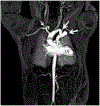PHACE Syndrome: Consensus-Derived Diagnosis and Care Recommendations
- PMID: 27659028
- PMCID: PMC6599593
- DOI: 10.1016/j.jpeds.2016.07.054
PHACE Syndrome: Consensus-Derived Diagnosis and Care Recommendations
Keywords: PHACE; PHACES syndrome; aortic coarctation; infantile hemangioma.
Figures





References
-
- Smart Tots. San Francisco: c2012–2015. http://www.smarttots.org. Accessed December 2015.
-
- Haggstrom AN, Garzon MC, Baselga E, Chamlin SL, Frieden IJ, Holland K, et al. Risk for PHACE syndrome in infants with large facial hemangiomas. Pediatrics 2010;126:e418–26. - PubMed
-
- Brandon K, Burrows P, Hess C, Metry D. Arteriovenous malformation: a rare manifestation of PHACE syndrome. Pediatr Dermatol 2011;28:180–4. - PubMed
-
- Chan YC, Eichenfield LF, Malchiodi J, Friedlander SF. Small facial haemangioma and supraumbilical raphe—a forme fruste of PHACES syndrome? Br J Dermatol 2005;153:1053–7. - PubMed
-
- Nabatian AS, Milgraum SS, Hess CP, Mancini AJ, Krol A, Frieden IJ. PHACE without face? Infantile hemangiomas of the upper body region with minimal or absent facial hemangiomas and associated structural malformations. Pediatr Dermatol 2011;28:235–41. - PubMed
Publication types
MeSH terms
Supplementary concepts
Grants and funding
LinkOut - more resources
Full Text Sources
Other Literature Sources

